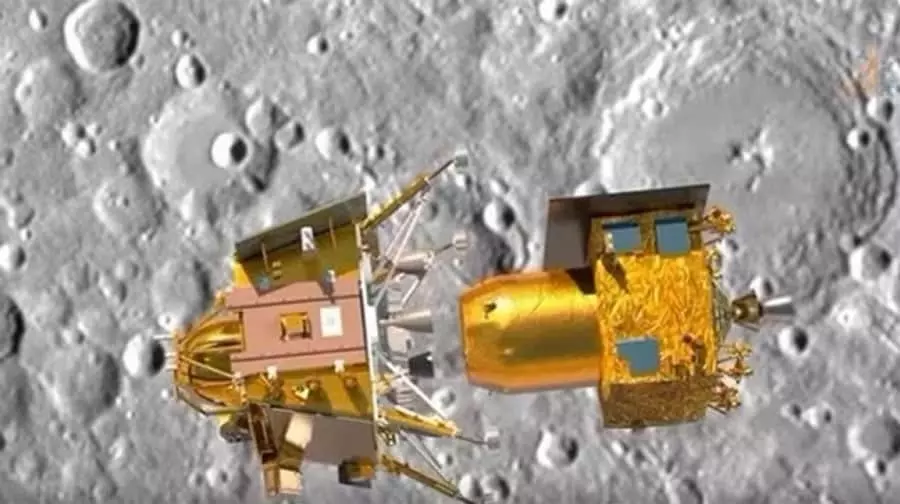
How India's audacious Lunar Mission will rewrite all rules of space exploration
It has broad scientific objectives, from the search for potential life on other celestial bodies to the possibility of using the Moon as a base for future space travel

India's latest lunar mission, Chandrayaan-3, is poised to make ground-breaking contributions to space exploration, and its impact will reach far beyond our Moon.
The SHAPE module (Spectro-polarimetry of Habitable Planet Earth) is one of the mission's key investigations. The SHAPE system will observe the Earth from the Moon's orbit. In simpler terms, SHAPE is like a special camera on the Moon that takes detailed pictures of Earth's light. These pictures help scientists understand Earth's light when observed from space and how it changes when it bounces off our planet. This can tell us more about Earth's environment and might even help in finding similar environments on other planets in the future.
A former director of the Indian Space Research Organisation (ISRO) told The Federal that this SHAPE endeavour aims to use its lunar base to transfer biological markers from Earth to numerous astronomical targets. If these markers detect similar evidence of life on other moons or planets, it would be a historic discovery that could change our view of life's existence beyond Earth.
The Chandrayaan-3 cost the Indian government ₹615 crore, according to former ISRO chairman K Sivan, which is lower than the Chandrayaan-2, which cost ₹791.30 crore. Out of ₹615 crore, ₹250 crore was spent to build the lander, rover, and propulsion systems, while the launch itself cost around ₹365 crore. Luna-25 cost the Russians about ₹1,600 crore. As per reports, a recent Indian movie, Adipurush, cost ₹700 crore for its production.
Substantial research
The Chandrayaan-3 mission, however, continues after the quest for extra-terrestrial life. It will also perform substantial research on the Moon, particularly its South Pole. The mission will examine crucial components such as helium and the water content of lunar rocks and minerals. Finding significant water reserves could have practical benefits such as turning the Moon into a refuelling station for future space flights.
The Moon might serve as a launch pad for excursions deeper into the universe by turning water into hydrogen and oxygen, reflecting the goals of the US Artemis mission, which also aspires to explore the Moon as a stepping stone for potential Mars colonisation.
The mission's specialised Instrument for Lunar Seismic Activity, or ILSA, is also critical. This instrument is intended to measure and record seismic activity on the lunar surface. Because seismic vibrations on the Moon are projected to be a thousand times less than those on Earth, confirming this concept could have implications for future lunar missions and Earth-based seismic models. An improved understanding of the Moon's seismic activity could help us predict earthquake frequencies on Earth, benefiting life on our planet directly, the scientist from ISRO, who did not wish to be named, said.
Extreme environmental conditions
Chandrayaan-3 will similarly attempt to negotiate the Moon's wildly-changing environment. With one lunar cycle consisting of 14 days of uninterrupted sunlight followed by a similar period of complete darkness and freezing temperatures (temperatures can drop to minus 250 degrees Fahrenheit), these extreme environmental factors are critical for future planning of sustainable human habitats on the Moon or other celestial bodies.
The mission's emphasis also includes the lunar dirt. The dirt of the Moon, known as regolith, contains vital information about its evolution and, by extension, the early days of our solar system. A company in Tamil Nadu has created synthetic lunar soil that has assisted ISRO in soft-landing manoeuvres, demonstrating an effective collaboration between the public and commercial sectors.
NASA has supplied a LASER Retroreflector Array to the mission as part of a collaborative effort. This instrument will offer crucial real-time data on the distance between the Earth and the Moon, adding to our understanding of lunar orbital dynamics. Furthermore, Chandrayaan-3 is home to several exciting experiments and equipment, including the Chandra Surface Thermo-Physical Experiment (ChaSTE), RAMBHA, and Langmuir Probe. This equipment will research how the Moon's crust reacts to temperature fluctuations and near-surface plasma conditions.
Multi-faceted mission
In summary, Chandrayaan-3 is a multi-faceted mission with broad scientific objectives spanning from the search for potential life on other celestial bodies to the possibility of using the Moon as a base for future space travel. The mission will also help us better comprehend Earth's seismic activity, lunar climatic conditions, and the Moon's distinctive geological makeup. With such a varied range of goals, Chandrayaan-3 is poised to represent a watershed moment in India's space exploration history.
According to experts, Chandrayaan-3's mission is notable for its scientific goals and collaborative and integrative approach. The successful collaboration of the public and corporate sectors and international partnerships lays the groundwork for future complex space missions.
Furthermore, the mission is projected to have far-reaching consequences for India's educational system. It offers a variety of learning materials that could impact curricula, making it a fruitful ground for research.
Other participants in the Lunar Mission:
Tata Elxsi Ltd: Engaged in crafting spacecraft, avionics, and specialised software.
Tata Advance System: Responsible for creating the lander for Chandrayaan-3.
Larsen & Toubro Ltd: In charge of developing the launch pad and additional infrastructure for ISRO.
MTAR Technologies Ltd: A long-time partner in producing rocket engines and core pumps for ISRO.
Bharat Electronics Ltd: Tasked with crafting the payloads for Chandrayaan-3.
Hindustan Aeronautics Ltd: Collaborating on developing the lander and providing mechanical support equipment.
Centum Electronics Ltd: Designed, developed, and manufactured electronic systems for space applications.

